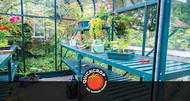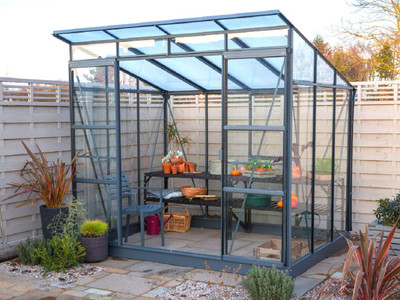How to grow in a greenhouse

Whatever style of greenhouse you opt for - whether it’s a ‘lean-to’, a compact house or a larger one - it will open up new possibilities for you and extend your growing season. It’s also a very pleasant and tranquil place to spend some ‘me-time’. It’s not all plain sailing though: the hobby (or job as the case may be) can demand a fair amount of attention and planning. Growing in a greenhouse can often be a bit like performing a multi-tasking dance. Maintaining a delicate balance is the name of the game, particularly during hot or cold spells of weather.
Planning
Choose plants that are right for the conditions. Exotic or heat-loving plants might do better in the greenhouse than outside, but they’ll probably still struggle when temperatures get cooler at night - unless you’re prepared to provide additional heat sources. Similarly, plants that are sensitive to heat and humidity will find themselves out of their depth during the warmer months.
Decide how you’re going to lay out the greenhouse: will you be growing in raised beds? Pots or propagators? Maybe even planting directly into the soil? The choice is yours but each option will mean taking a different approach. Grow bags and garden fleece can also be used for crops where needed.
A greenhouse provides shelter from the elements and gives you up to a four-week head start on growing, compared to outdoor plants. As you can imagine, it won’t be so suitable for overwintering tender plants…Some suitable crops for growing in a greenhouse during the warmer months include:
- Tomatoes
- Aubergines
- Peppers
- Courgettes
- Sweet potato
- Squash
- French beans
- Sweet corn
In the slightly cooler conditions of spring and autumn you can use the greenhouse for:
- Lettuce
- Asian salads
- Radish
- Beetroot
- Spring bulbs
- Carrots
- Spinach
- Asparagus
Propagation
A greenhouse provides you with an ideal climate for raising plants from seedlings or cuttings (which are pruned from existing plants). When you start your seeds in the greenhouse, you can then transplant them outside or into a cold frame or cloche - whatever your preference might be.
Warm soil and a fairly consistent temperature are two cornerstones of successful seedling growth. Drastic changes in temperature can damage vulnerable seedlings at this stage of their life-cycle. Therefore it’s important to provide a stable climate for them. A heat mat can be placed under your seedling trays: this can warm the temperature of the soil by about 10°C compared to surrounding conditions. For more precision and control, soil warming cables can be combined with a thermostat so that the cable comes on when it’s needed, such as during frosty patches or cold snaps. Additionally, wi-fi-enabled temperature monitors can alert you when the temperature levels in the greenhouse need your attention.
View Product: Biogreen Soil Warming Cable
Ventilation
When it comes to ventilation, the point of entry - namely your door - will play a crucial role during warmer and stuffier conditions. You can have single, double or sliding doors, but leave them at least partially open to allow for air circulation when the greenhouse needs it. Louvred windows are common greenhouse features that provide adjustable airflow and ventilation. Roof vents are also an option, often sold as an extra by suppliers such as Vitavia. You can also set up a more elaborate system in your greenhouse involving automated cooling, ventilation or temperature control.
Shading and Temperature Control
It’s important to keep temperatures down during prolonged periods of hot or dry weather. Plants within the greenhouse are vulnerable to overheating and the associated problems that go with it, such as heat stress or leaf scorch. Ventilation can help with this of course, but in very warm weather it won’t be enough. So what then? Maybe one of the most effective and inexpensive methods of protecting your crops is by using shade blinds, or shade cloth. The big advantage of these is that they can be pulled up or down depending on conditions (and as we know, conditions in this part of the world can swing from one extreme to the other). As the shade/blind protects crops from strong sunlight, it also absorbs the heat like some kind of solar sponge. Additionally, it can be pulled down at night to better keep warmth contained in the greenhouse. Because shade cloth can block up to 75% of light, it’s in your best interests to be selective and smart about when you use it. This type of shading can come in different materials and densities (measured in percentages), so choose according to your needs. Another key thing to be aware of is whether the blinds are fitted internally or externally. External blinds will prevent the sun’s rays from passing through the glazing in the first place. Internal blinds will absorb some heat and thermal energy but they are somewhat less effective if cooling is your main priority.
Other options include mesh netting and shade paint. Netting is often draped around the outside frame but it’s also an option internally. It can be somewhat awkward to set up but it allows for good air circulation. Shade paint is usually white in colour and applied to the outside of the greenhouse. You remove it by washing it off at the end of the warm season. Naturally this doesn’t allow for a lot of adaptability when it comes to changing weather conditions. However, it is very effective at cooling the greenhouse while still letting valuable sunlight through. One further option of shading is by using the plants themselves: taller or more heat-tolerant plants can be strategically planted in order to protect more vulnerable ones.
Humidity
One of the most important tools in the greenhouse gardener’s arsenal is that of ‘damping down’. It’s a term you’ll hear a lot and it refers to a fairly simple process: you pour or spray water on the floor and other surfaces of the greenhouse (such as shelves and staging). As the water evaporates it raises the surrounding humidity levels. Why is this a good thing? Well, high humidity is key to healthy growth conditions in the greenhouse. In fact, optimal humidity is around 80% - at this level, crops thrive from the moisture in the air. If the moisture levels are too low on the other hand, they can start to suffer from thirst in the warm inner climate. It is important though to not let conditions sneak far above the 80% point. Excess moisture in the air can lead to condensation and dampness, which can be a breeding ground for disease.
Damping down may need to be done at least three times a day in the height of summer. The most important time of the day to do so is in the morning, and then as often as you like after that. There is also the option of placing a humidifier in your greenhouse. Not only will it do the work for you, but it can do it more effectively and reliably than ‘manual’ damping down.
Heat and Insulation
When it comes to cooler times of the year, insulation and heat retention become the pressing issues of the day. Providing an external heating source is always an option: these are often sold as purpose-built ‘greenhouse heaters’ and advertised as economical. Even so, it may not be the most appealing choice right now, with rising energy bills bearing down on all of us! There are some other ways of capturing, retaining and insulating heat, so with a bit of creativity you can keep costs down: think solar-powered heating or thermal curtains. A ‘thermal sink’ can also be set up using water barrels or containers, which will absorb thermal energy during the day and release it at night.
A layer of bubble wrap can be used to insulate greenhouses during colder weather. Just make sure to go for horticultural bubble wrap rather than the common-or-garden type: it’s UV-stabilised and the larger bubbles lead to better insulation. Additionally, tender crops can be covered with garden fleece during cooler spells. The greenhouse can even be divided in such a way as to separate more tender plants from hardier ones.
Tip: the more plants you have in your greenhouse and the fuller it is, the more it will be able to retain heat overnight as compared to a half-empty one.
Disease and Pests
Isolate and separate any plants that show signs of being affected by pests or disease. Think ‘social distancing’ and ‘quarantine’! It’s vital that the problem doesn’t spread to surrounding plants as these problems can spread fast in the humid conditions of a greenhouse.
If you’re moving pots into the greenhouse for use, ensure that they’ve been cleaned and disinfected. Similarly, if moving plants inside give them a quick once-over for any signs of disease or damage. It will be much easier to nip it in the bud at an early stage and prevent introducing a problem to the enclosed greenhouse environment.




